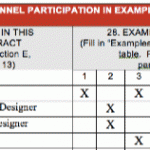
Requests For Proposals (RFPs) are not perfect.
Personally, out of the thousands of rfps that have passed before me, I have yet to see one perfect RFP.
The problems come when the rfp has confusing, illogical, contradictory or ambiguous language.
You may just shrug your shoulders and say, “well, I’ll just give them what they ask for.” But that is often the wrong approach. You have to understand that creating an rfp is no easy task.
Especially, if you as a procurement professional have many other rfps to write and get out on the street. What you often end up with are errors of copy and paste. Language may appear in your rfp that was originally intended for another rfp. It’s a common and very human mistake.
That’s why it’s very important, as the proposer, to read these rfps not as gospel, but as a document created for humans, by humans. Ask questions during the official question and answer period to clarify the intent of the rfp. Procurement officials and selection committees want to see proposals that allow them to make quick, informed, and correct decision.





Speak Your Mind